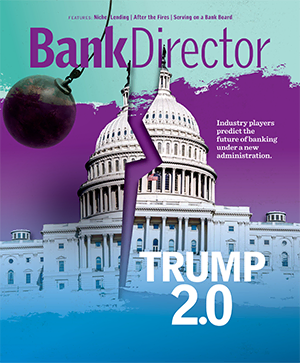
Leveraging Personal Loans to Drive Growth and Better Support Consumers
With transparency and responsible lending practices, banks can deepen customer relationships, strengthen their portfolios and help consumers achieve their financial goals.
Brought to you by Happy Money
Today’s banking leaders are navigating rising costs, margin pressures and intensifying competition. At the same time, consumers are facing record-high credit card debt and persistent inflation which has shaken consumer confidence. In this environment, forward-looking banks have a significant opportunity to reinforce their position as trusted partners by supporting customers with smart financial solutions.
Strategic personal lending has emerged as a notable opportunity. Strategically implemented, personal loans offer banks a way to diversify their portfolios with high-yield assets while helping customers achieve their financial goals.
A Pulse Check on Consumer Financial Pain Points
Americans are feeling the strain of rising costs across nearly every corner of daily life, from groceries and rent to transportation, causing many households to rely heavily on credit cards to cover everyday expenses. U.S. household debt has reached over $18 trillion, with more than $1 trillion of that debt being held in credit cards and average interest rates exceeding 20%, according to the Federal Reserve Bank of New York. For individuals juggling multiple high-interest balances, the compounding effect is often a burdensome, emotionally exhausting cycle of minimum payments and increasing revolving debt. In fact, according to a recent J.D. Power study, 53% of consumers report heightened concern about their financial situation, with 24% describing themselves as “very stressed.”
For banks, this signals an opportunity to step in and help consumers regain control of their finances while also driving sustainable growth for their financial institution.
Debt Consolidation as a Strategic Lifeline
In the face of such mounting pressure, debt consolidation has become top of mind for many Americans. However, not all approaches are created equal. Credit card balance transfers, for example, can offer low or 0% introductory rates but often come with transfer fees and a sharp rate increase once the promotional period ends.
One strong but sometimes overlooked option is consolidating debt through personal lending. When used responsibly, personal loans allow consumers to convert variable, high-interest credit card debt into a fixed-rate installment with predictable monthly payments. Recent Bankrate data shows that the average interest rate on personal loans is 12.58%, while credit card rates average over 20%. This offers a compelling opportunity for borrowers to pay off debt more quickly and affordably.
This strategy also presents a valuable opportunity for banks. While traditionally focused more heavily on mortgage and small-business lending, a strategic personal loan program can allow banks to diversify revenue streams, reduce reliance on real estate and commercial loans and deliver strong risk-adjusted returns through cycles. Perhaps most importantly, it can also help to deepen relationships with existing customers and attract new borrowers who are looking to reduce debt — all while reinforcing the bank’s role as a trusted financial partner.
Prioritizing the Right Approach
To effectively drive growth, personal lending must be delivered with the same rigor and discipline that banks bring to other asset classes. First, transparency should be a top priority, making the total cost of borrowing clear from the onset. Structured repayment options, upfront terms and embedded education around responsible borrowing empowers consumers to make smarter, more informed decisions.
Just as important is the delivery mechanism. Today’s borrowers expect intuitive, fast, digital-first experiences. That means banks need modern infrastructure, data-driven underwriting and streamlined workflows to execute efficiently. Plus, a compelling digital-first solution helps banks attract and engage with younger consumers, extending their reach beyond traditional branch doors.
Rather than building these capabilities from scratch, many institutions are finding value in partnering with fintech platforms that specialize in consumer lending. These partnerships allow banks to remain focused on relationship management, customer trust and long-term strategy while still reaping the benefits of the fintech’s technology-enabled infrastructure and scale.
Looking Ahead
In a world of financial complexity and uncertainty, banks have an opportunity to address the pressing consumer need for debt consolidation while also positioning themselves for sustainable growth. With the right combination of transparency, responsible lending practices and technology-driven execution, banks can deepen customer relationships, strengthen their portfolios and help consumers more successfully achieve their financial goals.


